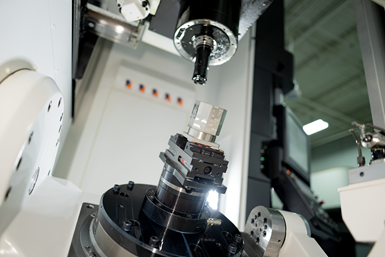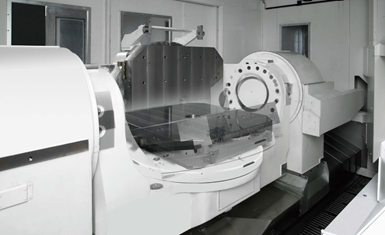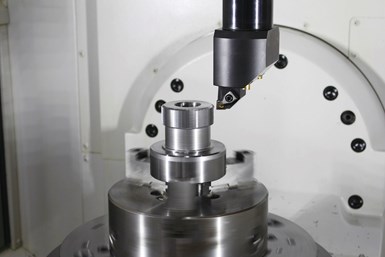Building a 5-Axis Cell
Sponsored Content5-axis machining has taken over the metalworking industry, but what goes into a high-functioning 5-axis machining cell?
Share
Five-axis machine tools have surged in popularity due to both the variety of unique applications and the reduction in setup changes. However, building a five-axis cell is not as simple as purchasing the machine tool.
While today it seems nearly every shop is interested in five-axis machining, the question of what five-axis machine tool they should buy is difficult to answer. Numerous features built into the machine tool itself help determine its effectiveness at producing complex parts efficiently and quickly. Furthermore, when setting up a five-axis machining cell, it is important to consider what systems will be integrated with the machine tool. Automation, for example, is often the key to making certain jobs more lucrative and knowing how your shop will tackle the automation challenge is helpful when picking out a machine tool.
Let’s take a look at what features go into making a five-axis machine tool that can cut complex parts at exacting tolerance.
The Machine Tool Body: Mass and Rigidity
As with any machine tool, rigidity is a major factor to consider when buying a five-axis machine tool. If anything, trunnion-style five-axis tables lose a degree of rigidity to achieve the five axes of motion, making increasing the rigidity of the machine tool through other features even more important. And one of the best ways to improve rigidity is to increase the mass of the machine tool.
The turbine relies on five simultaneous axes of movement to produce the contours needed for the application. Producing this part at the necessary tolerance places a high demand on the rigidity of the machine tool.
Heavy granite or cast-iron beds can dramatically increase the mass of a machine tool, and unlike an upscale toolholder or solid workholding, this cannot be added later. Achieving the proper rigidity for five-axis machining means paying the cost of a heavier machine tool. However, the benefits are more than worth the cost. “A heavier machine dissipates cutting energy away from the tool tip, resulting in quieter cuts, better surface finishes, and increased tool life,” says Okuma Regional Sales Manager Brandon Glenn. Glenn cites Okuma as an example of machine tools with a lot of mass and improved rigidity. “In extreme cases, we’ve had customers who switched to high-end machines experience an 80% reduction in monthly carbide costs,” he says.
The trunnion tables found in most five-axis mills are less rigid than a stationary work area, which means that the machine tool has to increase its rigidity in other areas. Okuma machines, for example, increase the mass to improve rigidity and reduce chatter.
Of course, the increased rigidity has benefits that extend much further than reducing chatter and improving tool life. More rigid machines can handle more aggressive machining strategies, which can reduce the time spent machining and increase a job’s profitability. This can mean heavy hogging, high-speed machining, high-feed machining, or other strategies that put a great deal of strain on the spindle. Without the improved rigidity from a heavier machine, these strategies could easily damage the spindle, tooling, or part - leading to costly downtime.
There is simply no aspect of machining that is not improved by rigidity. A heavy machine body enables manufacturers to achieve better finishes, higher metal removal rates, and better tool life.
Keeping Cool: Maintaining Thermal Stability
One of the less obvious features of a machine tool is also one of the most important: its thermal stability. Precision is a combination of accuracy and repeatability, and a machine tool that cannot control heat generation cannot achieve the repeatability – and therefore the precision – needed for five-axis machining.
Thermal stability is vital for maintaining the repeatability of a machining process. Okuma’s TFC process, for example, improves dimensional stability and reduces the need for manual adjustments due to heat buildup.
This is because as components of the machine tool move or when the cutting tool engages the part over the course of a machining cycle, the components generate heat that can cause them to expand. This expansion can affect the kinematics of the machine, allowing inaccuracies to creep into a toolpath. Heating occurs in every moving part, and controlling it requires more than just using coolant on the cutting tool.
Many design decisions go into making a machine thermally stable. Higher-end machines often use coolant not only in the cut, but also in the spindle itself, as well as in other areas such as the guideways. Okuma developed the Thermo-Friendly Concept (TFC), an approach to thermal stability that relies on adjustments to both the machine and program to compensate for thermal growth. This approach provides dimensional stability even over long machining cycles, eliminating the need for manual adjustments to compensate for heat buildup.
By managing heat through these systems built into the machine tool, the user can reduce scrap and keep the machine operating close to optimal performance. Over the long term, this can make difficult jobs profitable and significantly reduce the cost of both material and tooling. Sometimes, money spent is money saved.
Keeping Pace with Production: Integrating Automation
While the physical properties of the machine tool are vital, it is also important to know how the machine tool interacts with add-ons. For example, a major decision when purchasing a five-axis cell is to what degree you plan to automate the cell. If the shop is not hurting for labor, a tool changer with enough slots in the magazine to cover each shift will suffice, but many manufacturers are looking for more advanced automation solutions.
Knowing which automation system is needed for your application can be difficult. Some machine tools, such as Okumas, are designed to accommodate a range of potential automation systems.
There are multiple systems that are useful solutions for loading workpieces into five-axis machines, such as robots, gantry loaders, and pallet changers. All are excellent for high-volume production and, depending on the size and number of parts you are producing, any of them can work for a five-axis cell. However, not every five-axis machine tool is designed to easily accommodate automation.
Okuma designs its five-axis machines with the ability to easily integrate automation solutions into the cell. The Okuma STANDROID robot and Automatic Pallet Changers (APC) both connect modularly to multiple machine tool models, making a fully functional automated cell extremely accessible. This easy integration is useful to a shop, as it enables the user to plan automated and even lights-out manufacturing cells with a greater degree of confidence, because the automation system was designed with the machine tool in mind. This dramatically reduces the hiccups that often occur when setting up a new robotic cell.
For more information, visit Okuma.com.




